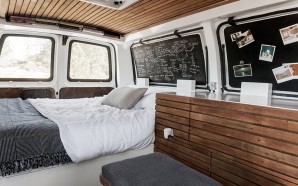The Domino Loft is the latest in a number of recent apartment builds that employ clever design and innovative features to make the most of limited space. Among them are the 538-sq ft (50-sq m) All I Own House, the 390-sq ft (36-sq m) 5:1 Apartment and the 226-sq ft (21-sq m) Micro-Apartment Moabit.
Located in the US city of San Francisco, the entire Domino Loft condo covers just 500 sq ft (46 sq m). While the kitchen and bathroom are in adjacent rooms, the rest of its functions are squeezed into one tiny remaining space.
The small amount of space might suggest that the options for the room were also limited, but design principle at ICOSA Charles Irby tells Gizmag that the firm actually considered about 10 different design strategies, with a number of different configurations for each. Scores for design effectiveness were calculated for each approach and, ultimately, a “loft approach” won out over bolder options that included features like drop-down ceiling panels and movable walls.

The master bed is raised up on top of the room’s main unit and is accessed via a sliding library ladder. The ladder is also used to access storage and can be slid out of the way when not in use. The master sleeping space doubles as a home theater seating area, with the mattress able to be folded up into a sofa position and a projector used to display content on the wall opposite.
Irby says the ICOSA team managed to create the thinnest and lightest fold-down bed that any of the team-members had seen, using an ultra-thin custom-fabricated aluminum frame with gas springs. When deployed, the bed fills the lower-level space below the master sleeping area. In its upright position, its underside functions as dry-erase board.

Part of the main unit forms a bench, for residents to sit when eating. The bench has built-in storage space and also functions as a platform for people to use when putting on their shoes. Elsewhere, the lower level of the unit serves as a closet, with a variety of spaces for different types of clothing.
The Domino Loft project took over year to complete, primarily due to working through the potential design strategies, and was completed in November 2015.
Source: ICOSA









